Operations Management Case Study: Kanban, Toyota, and JIT/TQM
VerifiedAdded on 2021/08/03
|11
|3464
|68
Case Study
AI Summary
This assignment is a case study focusing on the Kanban system within the Toyota Production System, exploring its key elements and appropriateness in a manufacturing context. It emphasizes the principles of Just-in-Time (JIT) and Total Quality Management (TQM). The case study, adapted from a Toyota supplier instruction document, details how the Kanban system minimizes work-in-process inventories and ensures efficient production through order cards that trigger production processes. It highlights essential conditions for efficient Kanban system implementation, including shorter setup times, minimizing defectives, thorough preventive maintenance, and adherence to operation standards. The assignment requires identifying these key elements, discussing their application in a specific organizational context, and providing evidence of how the Kanban system supports uninterrupted and effective manufacturing. The grading criteria emphasize a convincing identification of Kanban elements, analysis of factors influencing JIT and TQM, logical presentation of the manufacturing process, and meaningful inferences for tackling operational problems. Desklib provides a platform to access similar solved assignments and study resources.
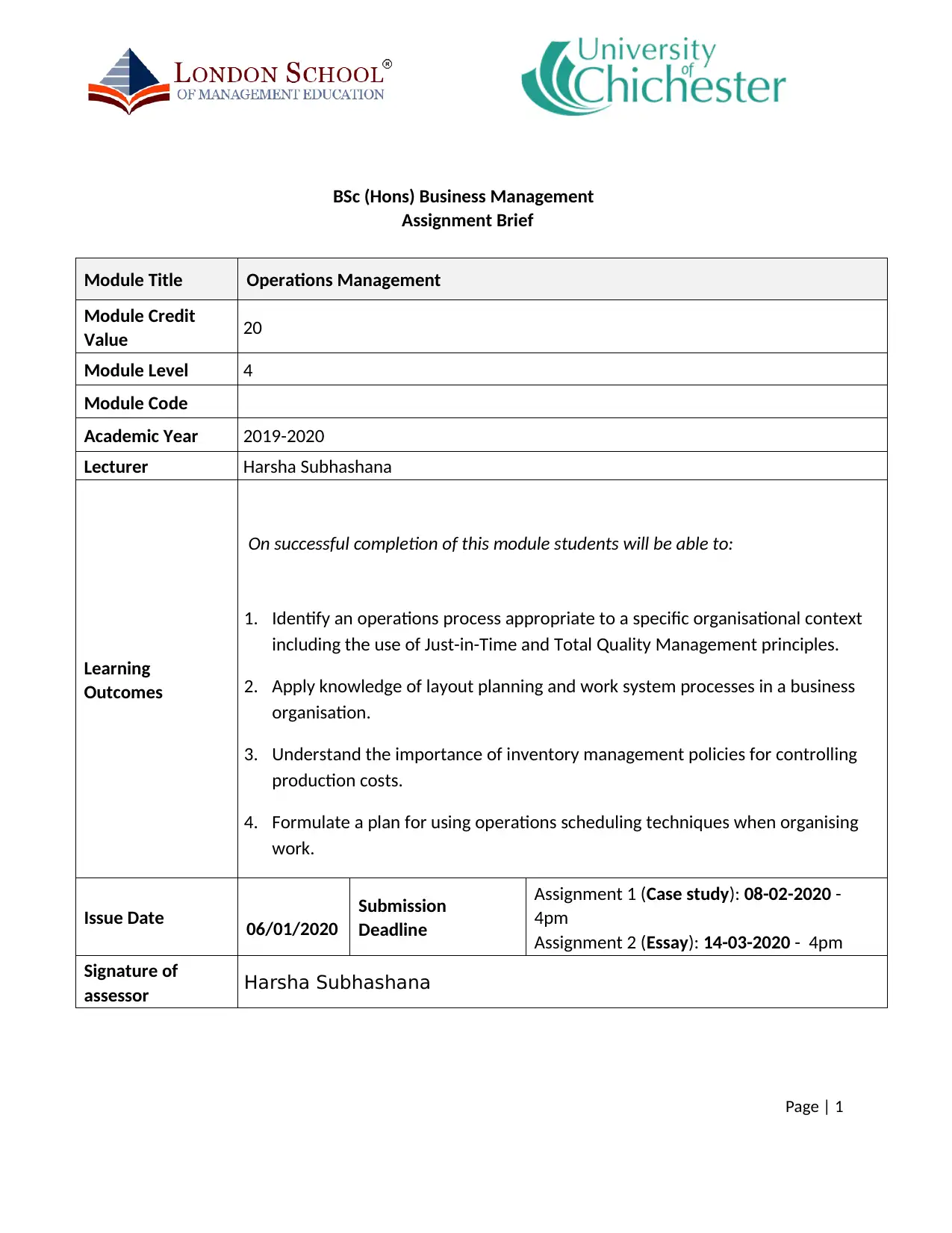
BSc (Hons) Business Management
Assignment Brief
Module Title Operations Management
Module Credit
Value 20
Module Level 4
Module Code
Academic Year 2019-2020
Lecturer Harsha Subhashana
Learning
Outcomes
On successful completion of this module students will be able to:
1. Identify an operations process appropriate to a specific organisational context
including the use of Just-in-Time and Total Quality Management principles.
2. Apply knowledge of layout planning and work system processes in a business
organisation.
3. Understand the importance of inventory management policies for controlling
production costs.
4. Formulate a plan for using operations scheduling techniques when organising
work.
Issue Date 06/01/2020
Submission
Deadline
Assignment 1 (Case study): 08-02-2020 -
4pm
Assignment 2 (Essay): 14-03-2020 - 4pm
Signature of
assessor Harsha Subhashana
Page | 1
Assignment Brief
Module Title Operations Management
Module Credit
Value 20
Module Level 4
Module Code
Academic Year 2019-2020
Lecturer Harsha Subhashana
Learning
Outcomes
On successful completion of this module students will be able to:
1. Identify an operations process appropriate to a specific organisational context
including the use of Just-in-Time and Total Quality Management principles.
2. Apply knowledge of layout planning and work system processes in a business
organisation.
3. Understand the importance of inventory management policies for controlling
production costs.
4. Formulate a plan for using operations scheduling techniques when organising
work.
Issue Date 06/01/2020
Submission
Deadline
Assignment 1 (Case study): 08-02-2020 -
4pm
Assignment 2 (Essay): 14-03-2020 - 4pm
Signature of
assessor Harsha Subhashana
Page | 1
Paraphrase This Document
Need a fresh take? Get an instant paraphrase of this document with our AI Paraphraser
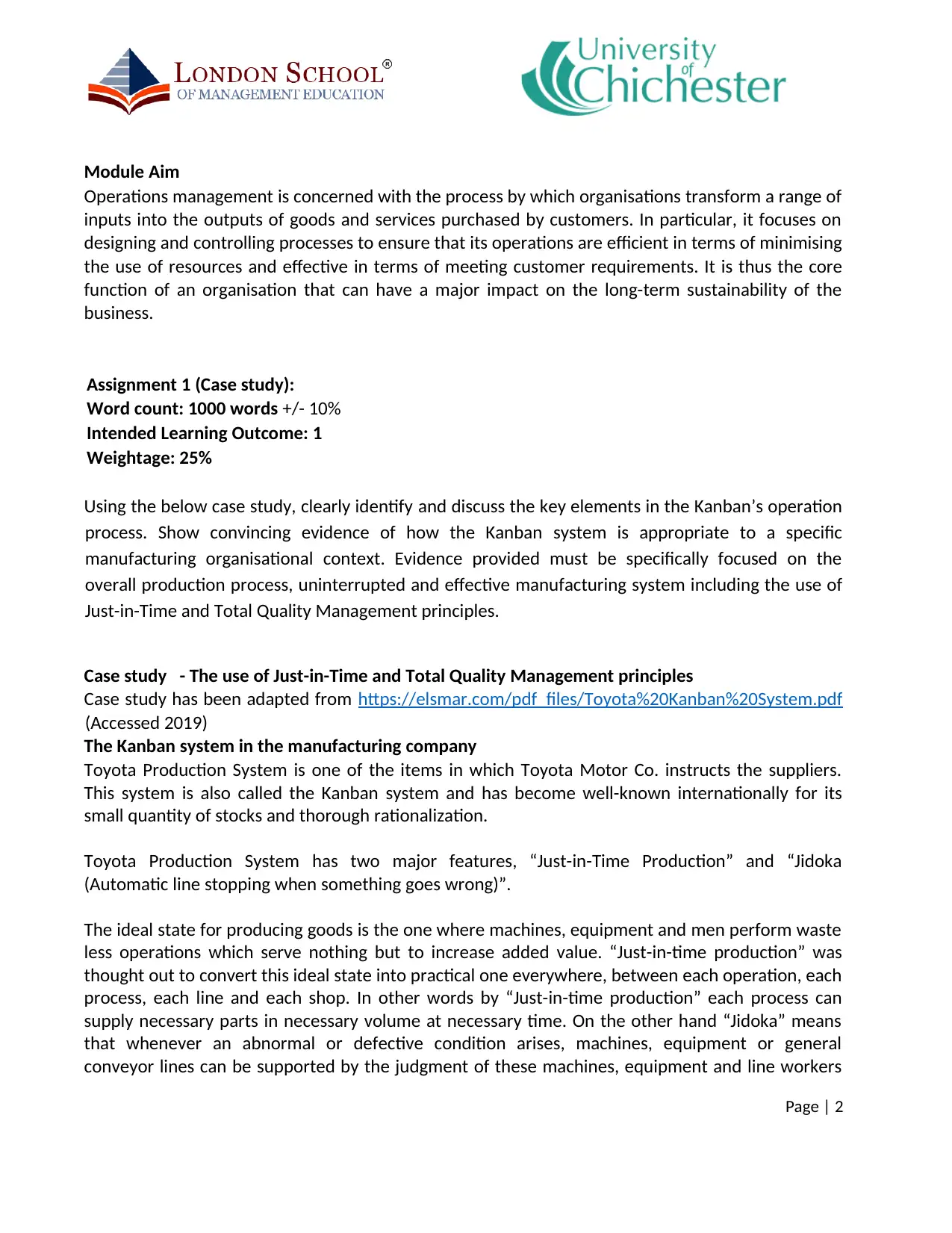
Module Aim
Operations management is concerned with the process by which organisations transform a range of
inputs into the outputs of goods and services purchased by customers. In particular, it focuses on
designing and controlling processes to ensure that its operations are efficient in terms of minimising
the use of resources and effective in terms of meeting customer requirements. It is thus the core
function of an organisation that can have a major impact on the long-term sustainability of the
business.
Assignment 1 (Case study):
Word count: 1000 words +/- 10%
Intended Learning Outcome: 1
Weightage: 25%
Using the below case study, clearly identify and discuss the key elements in the Kanban’s operation
process. Show convincing evidence of how the Kanban system is appropriate to a specific
manufacturing organisational context. Evidence provided must be specifically focused on the
overall production process, uninterrupted and effective manufacturing system including the use of
Just-in-Time and Total Quality Management principles.
Case study - The use of Just-in-Time and Total Quality Management principles
Case study has been adapted from https://elsmar.com/pdf_files/Toyota%20Kanban%20System.pdf
(Accessed 2019)
The Kanban system in the manufacturing company
Toyota Production System is one of the items in which Toyota Motor Co. instructs the suppliers.
This system is also called the Kanban system and has become well-known internationally for its
small quantity of stocks and thorough rationalization.
Toyota Production System has two major features, “Just-in-Time Production” and “Jidoka
(Automatic line stopping when something goes wrong)”.
The ideal state for producing goods is the one where machines, equipment and men perform waste
less operations which serve nothing but to increase added value. “Just-in-time production” was
thought out to convert this ideal state into practical one everywhere, between each operation, each
process, each line and each shop. In other words by “Just-in-time production” each process can
supply necessary parts in necessary volume at necessary time. On the other hand “Jidoka” means
that whenever an abnormal or defective condition arises, machines, equipment or general
conveyor lines can be supported by the judgment of these machines, equipment and line workers
Page | 2
Operations management is concerned with the process by which organisations transform a range of
inputs into the outputs of goods and services purchased by customers. In particular, it focuses on
designing and controlling processes to ensure that its operations are efficient in terms of minimising
the use of resources and effective in terms of meeting customer requirements. It is thus the core
function of an organisation that can have a major impact on the long-term sustainability of the
business.
Assignment 1 (Case study):
Word count: 1000 words +/- 10%
Intended Learning Outcome: 1
Weightage: 25%
Using the below case study, clearly identify and discuss the key elements in the Kanban’s operation
process. Show convincing evidence of how the Kanban system is appropriate to a specific
manufacturing organisational context. Evidence provided must be specifically focused on the
overall production process, uninterrupted and effective manufacturing system including the use of
Just-in-Time and Total Quality Management principles.
Case study - The use of Just-in-Time and Total Quality Management principles
Case study has been adapted from https://elsmar.com/pdf_files/Toyota%20Kanban%20System.pdf
(Accessed 2019)
The Kanban system in the manufacturing company
Toyota Production System is one of the items in which Toyota Motor Co. instructs the suppliers.
This system is also called the Kanban system and has become well-known internationally for its
small quantity of stocks and thorough rationalization.
Toyota Production System has two major features, “Just-in-Time Production” and “Jidoka
(Automatic line stopping when something goes wrong)”.
The ideal state for producing goods is the one where machines, equipment and men perform waste
less operations which serve nothing but to increase added value. “Just-in-time production” was
thought out to convert this ideal state into practical one everywhere, between each operation, each
process, each line and each shop. In other words by “Just-in-time production” each process can
supply necessary parts in necessary volume at necessary time. On the other hand “Jidoka” means
that whenever an abnormal or defective condition arises, machines, equipment or general
conveyor lines can be supported by the judgment of these machines, equipment and line workers
Page | 2
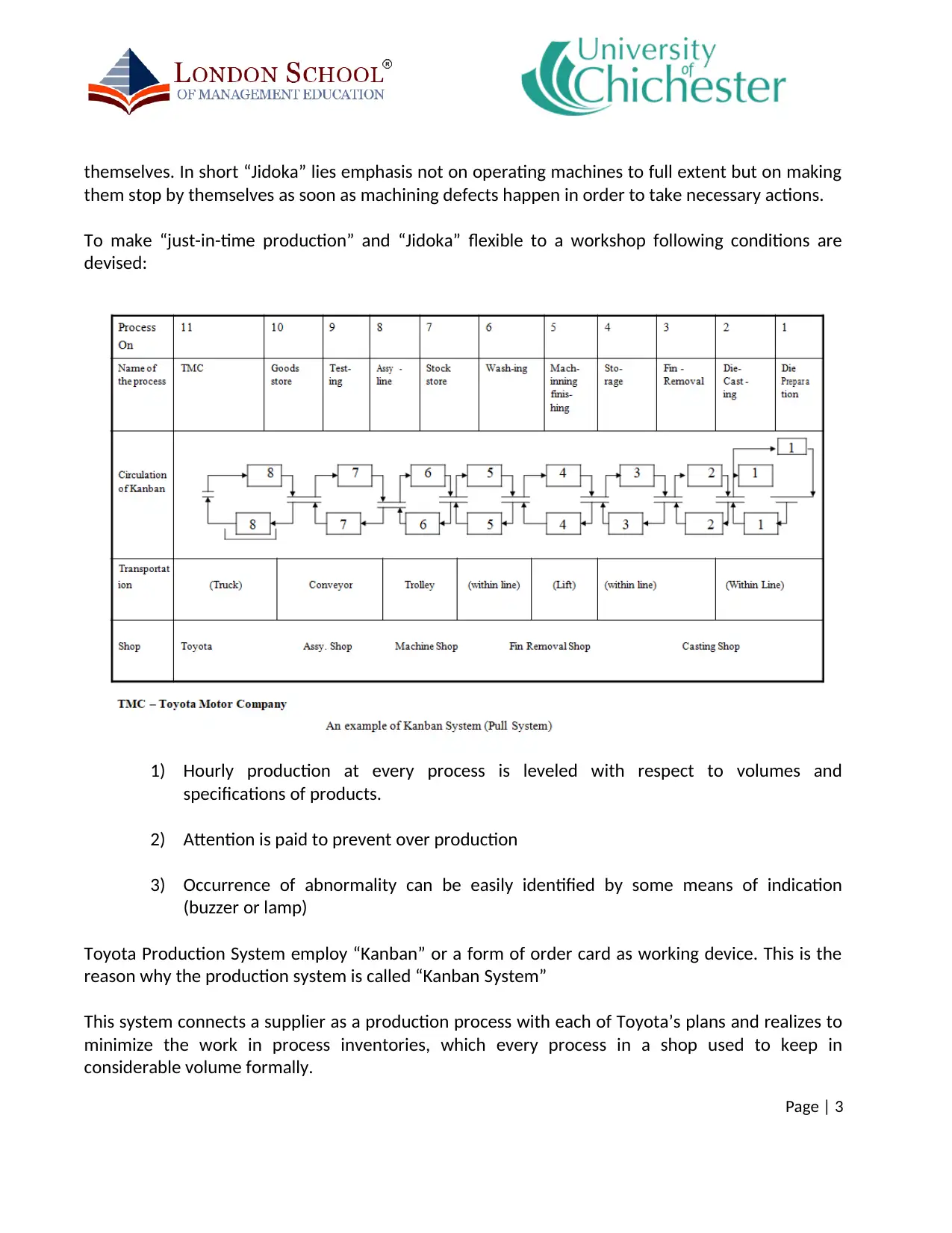
themselves. In short “Jidoka” lies emphasis not on operating machines to full extent but on making
them stop by themselves as soon as machining defects happen in order to take necessary actions.
To make “just-in-time production” and “Jidoka” flexible to a workshop following conditions are
devised:
1) Hourly production at every process is leveled with respect to volumes and
specifications of products.
2) Attention is paid to prevent over production
3) Occurrence of abnormality can be easily identified by some means of indication
(buzzer or lamp)
Toyota Production System employ “Kanban” or a form of order card as working device. This is the
reason why the production system is called “Kanban System”
This system connects a supplier as a production process with each of Toyota’s plans and realizes to
minimize the work in process inventories, which every process in a shop used to keep in
considerable volume formally.
Page | 3
them stop by themselves as soon as machining defects happen in order to take necessary actions.
To make “just-in-time production” and “Jidoka” flexible to a workshop following conditions are
devised:
1) Hourly production at every process is leveled with respect to volumes and
specifications of products.
2) Attention is paid to prevent over production
3) Occurrence of abnormality can be easily identified by some means of indication
(buzzer or lamp)
Toyota Production System employ “Kanban” or a form of order card as working device. This is the
reason why the production system is called “Kanban System”
This system connects a supplier as a production process with each of Toyota’s plans and realizes to
minimize the work in process inventories, which every process in a shop used to keep in
considerable volume formally.
Page | 3
⊘ This is a preview!⊘
Do you want full access?
Subscribe today to unlock all pages.

Trusted by 1+ million students worldwide
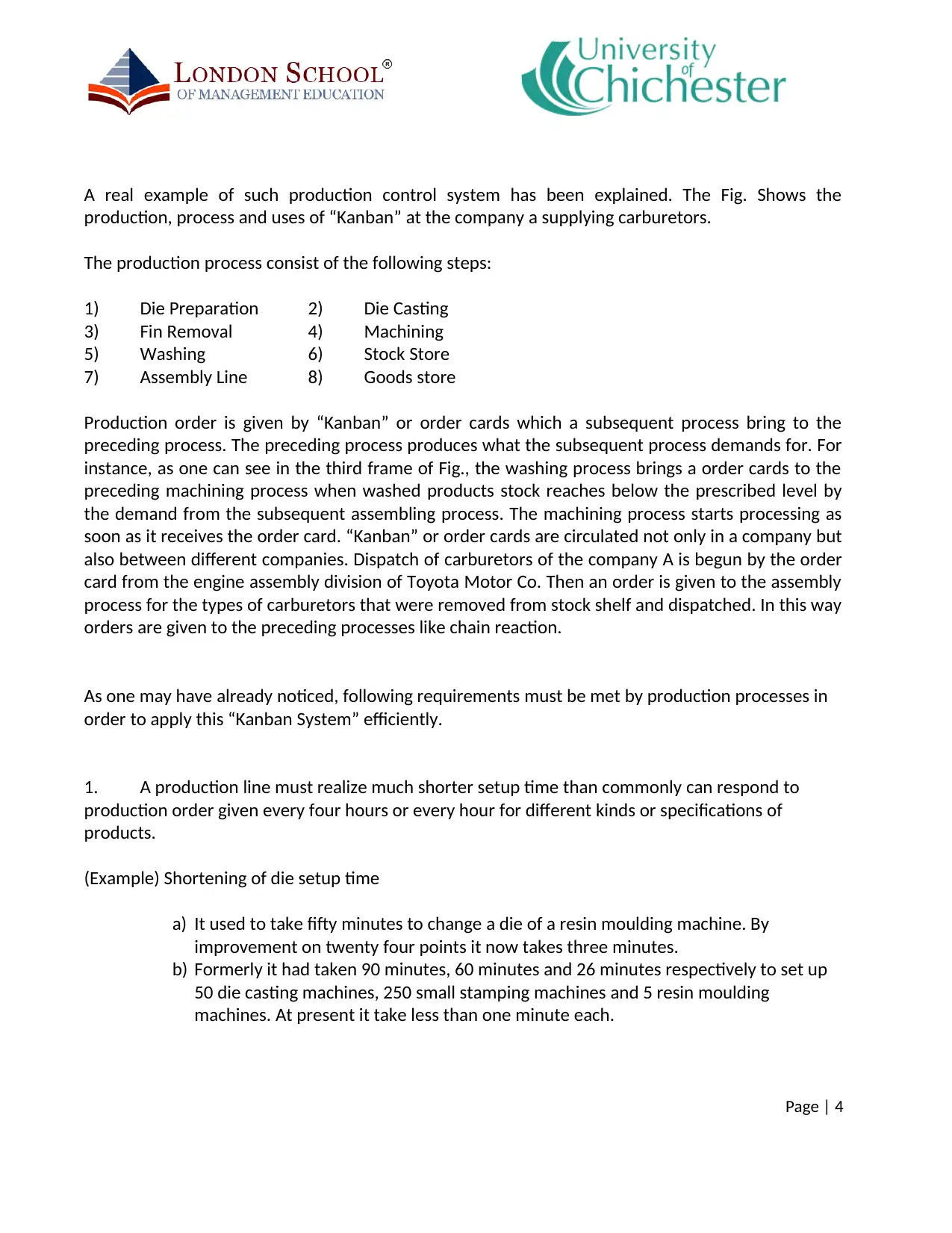
A real example of such production control system has been explained. The Fig. Shows the
production, process and uses of “Kanban” at the company a supplying carburetors.
The production process consist of the following steps:
1) Die Preparation 2) Die Casting
3) Fin Removal 4) Machining
5) Washing 6) Stock Store
7) Assembly Line 8) Goods store
Production order is given by “Kanban” or order cards which a subsequent process bring to the
preceding process. The preceding process produces what the subsequent process demands for. For
instance, as one can see in the third frame of Fig., the washing process brings a order cards to the
preceding machining process when washed products stock reaches below the prescribed level by
the demand from the subsequent assembling process. The machining process starts processing as
soon as it receives the order card. “Kanban” or order cards are circulated not only in a company but
also between different companies. Dispatch of carburetors of the company A is begun by the order
card from the engine assembly division of Toyota Motor Co. Then an order is given to the assembly
process for the types of carburetors that were removed from stock shelf and dispatched. In this way
orders are given to the preceding processes like chain reaction.
As one may have already noticed, following requirements must be met by production processes in
order to apply this “Kanban System” efficiently.
1. A production line must realize much shorter setup time than commonly can respond to
production order given every four hours or every hour for different kinds or specifications of
products.
(Example) Shortening of die setup time
a) It used to take fifty minutes to change a die of a resin moulding machine. By
improvement on twenty four points it now takes three minutes.
b) Formerly it had taken 90 minutes, 60 minutes and 26 minutes respectively to set up
50 die casting machines, 250 small stamping machines and 5 resin moulding
machines. At present it take less than one minute each.
Page | 4
production, process and uses of “Kanban” at the company a supplying carburetors.
The production process consist of the following steps:
1) Die Preparation 2) Die Casting
3) Fin Removal 4) Machining
5) Washing 6) Stock Store
7) Assembly Line 8) Goods store
Production order is given by “Kanban” or order cards which a subsequent process bring to the
preceding process. The preceding process produces what the subsequent process demands for. For
instance, as one can see in the third frame of Fig., the washing process brings a order cards to the
preceding machining process when washed products stock reaches below the prescribed level by
the demand from the subsequent assembling process. The machining process starts processing as
soon as it receives the order card. “Kanban” or order cards are circulated not only in a company but
also between different companies. Dispatch of carburetors of the company A is begun by the order
card from the engine assembly division of Toyota Motor Co. Then an order is given to the assembly
process for the types of carburetors that were removed from stock shelf and dispatched. In this way
orders are given to the preceding processes like chain reaction.
As one may have already noticed, following requirements must be met by production processes in
order to apply this “Kanban System” efficiently.
1. A production line must realize much shorter setup time than commonly can respond to
production order given every four hours or every hour for different kinds or specifications of
products.
(Example) Shortening of die setup time
a) It used to take fifty minutes to change a die of a resin moulding machine. By
improvement on twenty four points it now takes three minutes.
b) Formerly it had taken 90 minutes, 60 minutes and 26 minutes respectively to set up
50 die casting machines, 250 small stamping machines and 5 resin moulding
machines. At present it take less than one minute each.
Page | 4
Paraphrase This Document
Need a fresh take? Get an instant paraphrase of this document with our AI Paraphraser
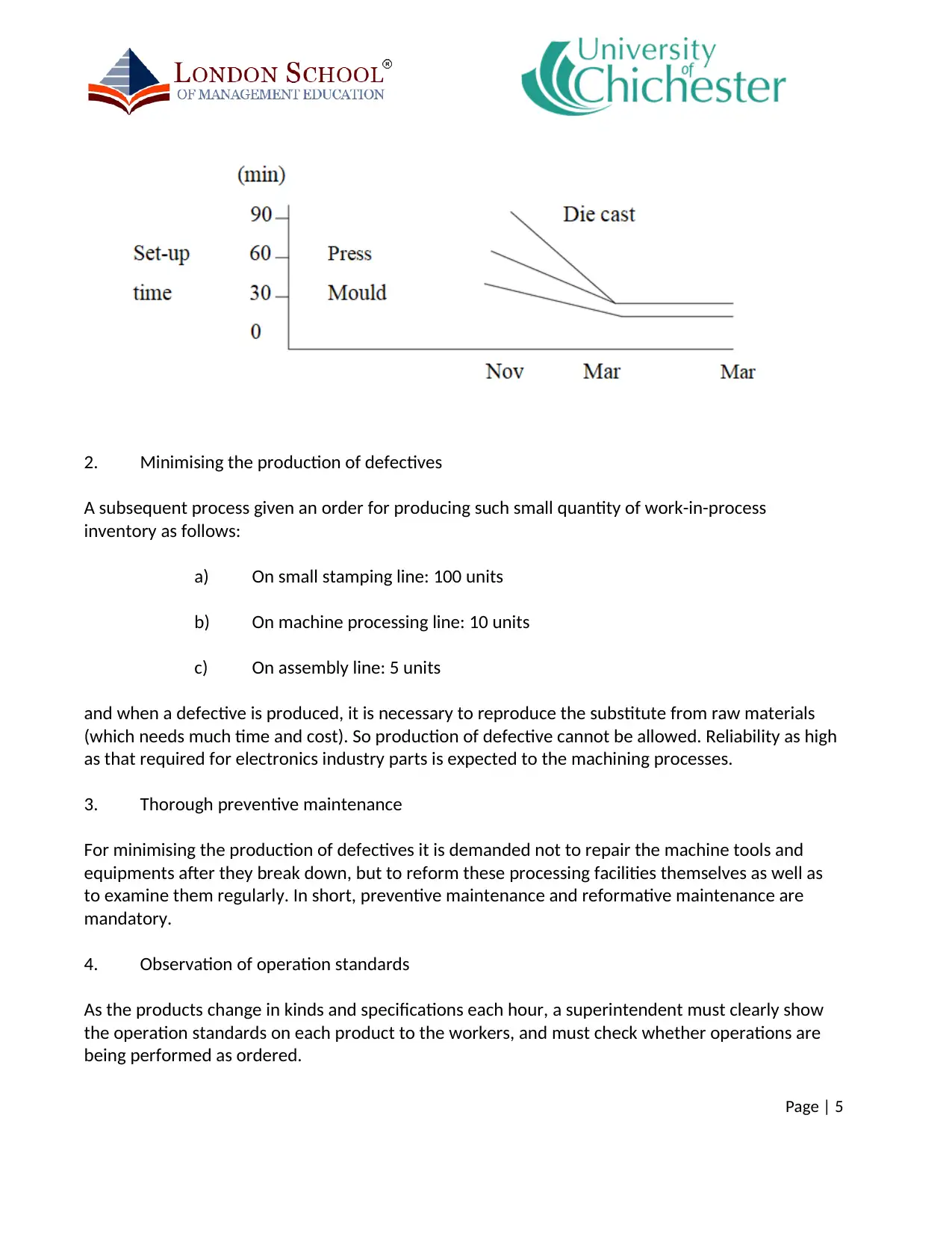
2. Minimising the production of defectives
A subsequent process given an order for producing such small quantity of work-in-process
inventory as follows:
a) On small stamping line: 100 units
b) On machine processing line: 10 units
c) On assembly line: 5 units
and when a defective is produced, it is necessary to reproduce the substitute from raw materials
(which needs much time and cost). So production of defective cannot be allowed. Reliability as high
as that required for electronics industry parts is expected to the machining processes.
3. Thorough preventive maintenance
For minimising the production of defectives it is demanded not to repair the machine tools and
equipments after they break down, but to reform these processing facilities themselves as well as
to examine them regularly. In short, preventive maintenance and reformative maintenance are
mandatory.
4. Observation of operation standards
As the products change in kinds and specifications each hour, a superintendent must clearly show
the operation standards on each product to the workers, and must check whether operations are
being performed as ordered.
Page | 5
A subsequent process given an order for producing such small quantity of work-in-process
inventory as follows:
a) On small stamping line: 100 units
b) On machine processing line: 10 units
c) On assembly line: 5 units
and when a defective is produced, it is necessary to reproduce the substitute from raw materials
(which needs much time and cost). So production of defective cannot be allowed. Reliability as high
as that required for electronics industry parts is expected to the machining processes.
3. Thorough preventive maintenance
For minimising the production of defectives it is demanded not to repair the machine tools and
equipments after they break down, but to reform these processing facilities themselves as well as
to examine them regularly. In short, preventive maintenance and reformative maintenance are
mandatory.
4. Observation of operation standards
As the products change in kinds and specifications each hour, a superintendent must clearly show
the operation standards on each product to the workers, and must check whether operations are
being performed as ordered.
Page | 5
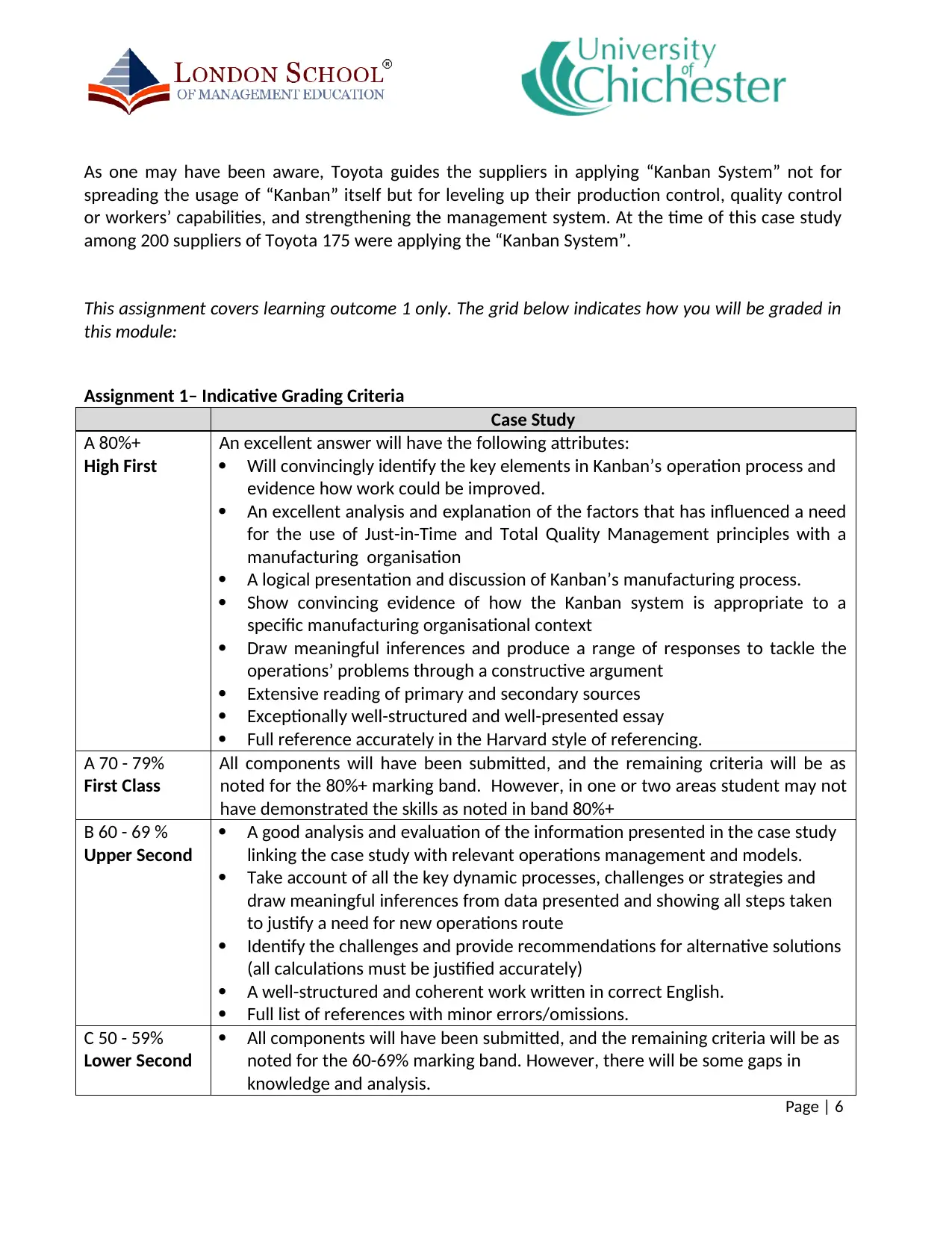
As one may have been aware, Toyota guides the suppliers in applying “Kanban System” not for
spreading the usage of “Kanban” itself but for leveling up their production control, quality control
or workers’ capabilities, and strengthening the management system. At the time of this case study
among 200 suppliers of Toyota 175 were applying the “Kanban System”.
This assignment covers learning outcome 1 only. The grid below indicates how you will be graded in
this module:
Assignment 1– Indicative Grading Criteria
Case Study
A 80%+
High First
An excellent answer will have the following attributes:
Will convincingly identify the key elements in Kanban’s operation process and
evidence how work could be improved.
An excellent analysis and explanation of the factors that has influenced a need
for the use of Just-in-Time and Total Quality Management principles with a
manufacturing organisation
A logical presentation and discussion of Kanban’s manufacturing process.
Show convincing evidence of how the Kanban system is appropriate to a
specific manufacturing organisational context
Draw meaningful inferences and produce a range of responses to tackle the
operations’ problems through a constructive argument
Extensive reading of primary and secondary sources
Exceptionally well-structured and well-presented essay
Full reference accurately in the Harvard style of referencing.
A 70 - 79%
First Class
All components will have been submitted, and the remaining criteria will be as
noted for the 80%+ marking band. However, in one or two areas student may not
have demonstrated the skills as noted in band 80%+
B 60 - 69 %
Upper Second
A good analysis and evaluation of the information presented in the case study
linking the case study with relevant operations management and models.
Take account of all the key dynamic processes, challenges or strategies and
draw meaningful inferences from data presented and showing all steps taken
to justify a need for new operations route
Identify the challenges and provide recommendations for alternative solutions
(all calculations must be justified accurately)
A well-structured and coherent work written in correct English.
Full list of references with minor errors/omissions.
C 50 - 59%
Lower Second
All components will have been submitted, and the remaining criteria will be as
noted for the 60-69% marking band. However, there will be some gaps in
knowledge and analysis.
Page | 6
spreading the usage of “Kanban” itself but for leveling up their production control, quality control
or workers’ capabilities, and strengthening the management system. At the time of this case study
among 200 suppliers of Toyota 175 were applying the “Kanban System”.
This assignment covers learning outcome 1 only. The grid below indicates how you will be graded in
this module:
Assignment 1– Indicative Grading Criteria
Case Study
A 80%+
High First
An excellent answer will have the following attributes:
Will convincingly identify the key elements in Kanban’s operation process and
evidence how work could be improved.
An excellent analysis and explanation of the factors that has influenced a need
for the use of Just-in-Time and Total Quality Management principles with a
manufacturing organisation
A logical presentation and discussion of Kanban’s manufacturing process.
Show convincing evidence of how the Kanban system is appropriate to a
specific manufacturing organisational context
Draw meaningful inferences and produce a range of responses to tackle the
operations’ problems through a constructive argument
Extensive reading of primary and secondary sources
Exceptionally well-structured and well-presented essay
Full reference accurately in the Harvard style of referencing.
A 70 - 79%
First Class
All components will have been submitted, and the remaining criteria will be as
noted for the 80%+ marking band. However, in one or two areas student may not
have demonstrated the skills as noted in band 80%+
B 60 - 69 %
Upper Second
A good analysis and evaluation of the information presented in the case study
linking the case study with relevant operations management and models.
Take account of all the key dynamic processes, challenges or strategies and
draw meaningful inferences from data presented and showing all steps taken
to justify a need for new operations route
Identify the challenges and provide recommendations for alternative solutions
(all calculations must be justified accurately)
A well-structured and coherent work written in correct English.
Full list of references with minor errors/omissions.
C 50 - 59%
Lower Second
All components will have been submitted, and the remaining criteria will be as
noted for the 60-69% marking band. However, there will be some gaps in
knowledge and analysis.
Page | 6
⊘ This is a preview!⊘
Do you want full access?
Subscribe today to unlock all pages.

Trusted by 1+ million students worldwide
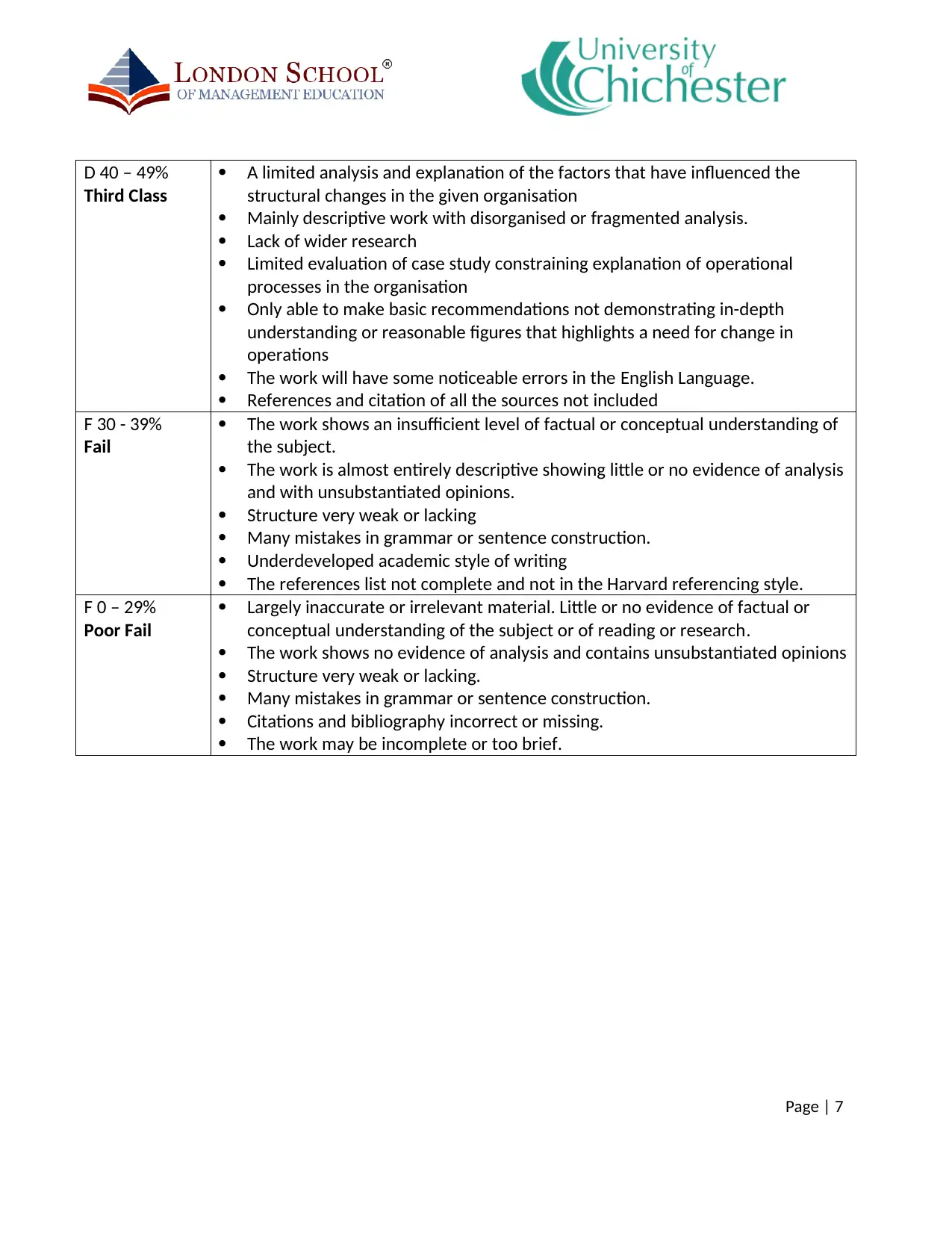
D 40 – 49%
Third Class
A limited analysis and explanation of the factors that have influenced the
structural changes in the given organisation
Mainly descriptive work with disorganised or fragmented analysis.
Lack of wider research
Limited evaluation of case study constraining explanation of operational
processes in the organisation
Only able to make basic recommendations not demonstrating in-depth
understanding or reasonable figures that highlights a need for change in
operations
The work will have some noticeable errors in the English Language.
References and citation of all the sources not included
F 30 - 39%
Fail
The work shows an insufficient level of factual or conceptual understanding of
the subject.
The work is almost entirely descriptive showing little or no evidence of analysis
and with unsubstantiated opinions.
Structure very weak or lacking
Many mistakes in grammar or sentence construction.
Underdeveloped academic style of writing
The references list not complete and not in the Harvard referencing style.
F 0 – 29%
Poor Fail
Largely inaccurate or irrelevant material. Little or no evidence of factual or
conceptual understanding of the subject or of reading or research.
The work shows no evidence of analysis and contains unsubstantiated opinions
Structure very weak or lacking.
Many mistakes in grammar or sentence construction.
Citations and bibliography incorrect or missing.
The work may be incomplete or too brief.
Page | 7
Third Class
A limited analysis and explanation of the factors that have influenced the
structural changes in the given organisation
Mainly descriptive work with disorganised or fragmented analysis.
Lack of wider research
Limited evaluation of case study constraining explanation of operational
processes in the organisation
Only able to make basic recommendations not demonstrating in-depth
understanding or reasonable figures that highlights a need for change in
operations
The work will have some noticeable errors in the English Language.
References and citation of all the sources not included
F 30 - 39%
Fail
The work shows an insufficient level of factual or conceptual understanding of
the subject.
The work is almost entirely descriptive showing little or no evidence of analysis
and with unsubstantiated opinions.
Structure very weak or lacking
Many mistakes in grammar or sentence construction.
Underdeveloped academic style of writing
The references list not complete and not in the Harvard referencing style.
F 0 – 29%
Poor Fail
Largely inaccurate or irrelevant material. Little or no evidence of factual or
conceptual understanding of the subject or of reading or research.
The work shows no evidence of analysis and contains unsubstantiated opinions
Structure very weak or lacking.
Many mistakes in grammar or sentence construction.
Citations and bibliography incorrect or missing.
The work may be incomplete or too brief.
Page | 7
Paraphrase This Document
Need a fresh take? Get an instant paraphrase of this document with our AI Paraphraser
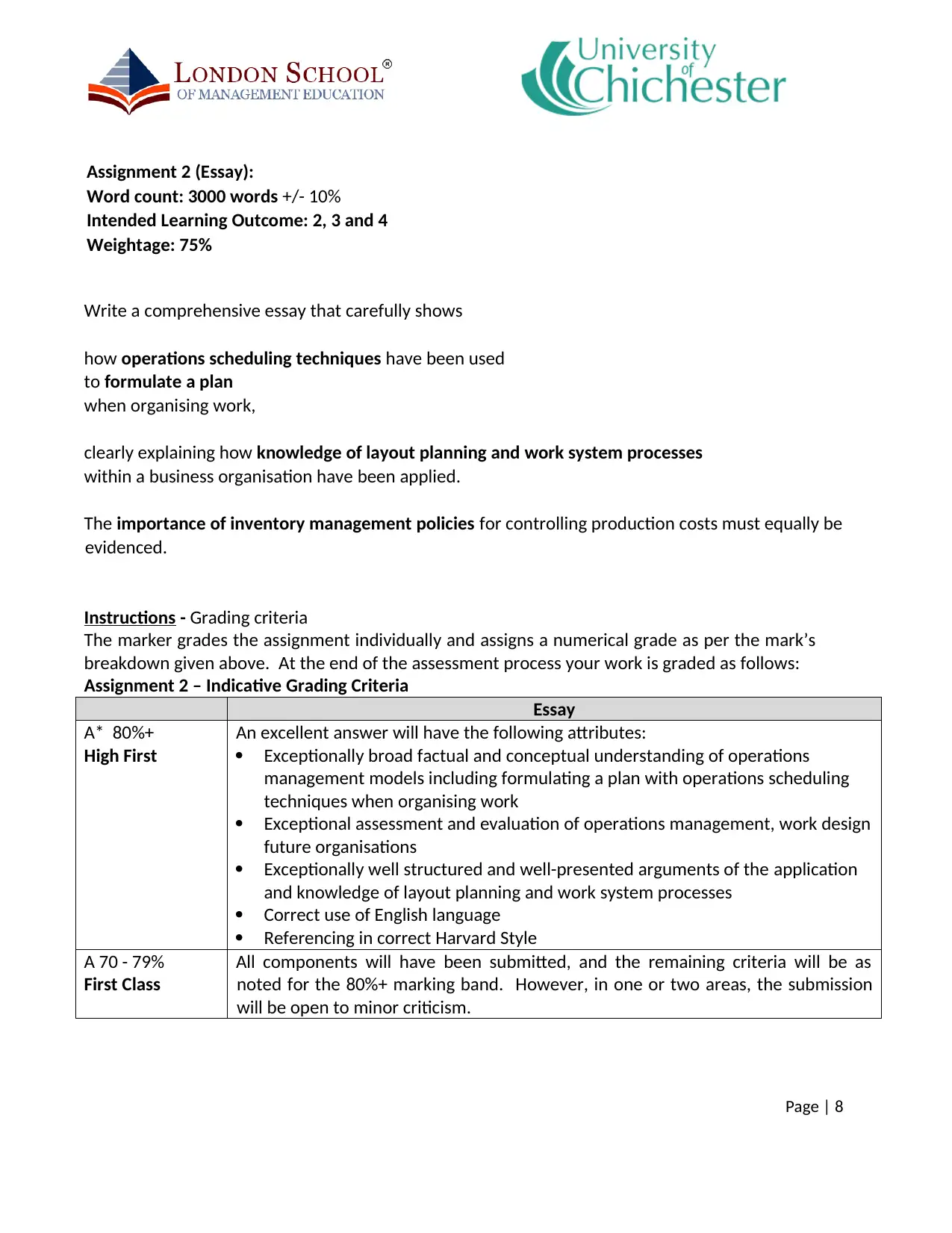
Assignment 2 (Essay):
Word count: 3000 words +/- 10%
Intended Learning Outcome: 2, 3 and 4
Weightage: 75%
Write a comprehensive essay that carefully shows
how operations scheduling techniques have been used
to formulate a plan
when organising work,
clearly explaining how knowledge of layout planning and work system processes
within a business organisation have been applied.
The importance of inventory management policies for controlling production costs must equally be
evidenced.
Instructions - Grading criteria
The marker grades the assignment individually and assigns a numerical grade as per the mark’s
breakdown given above. At the end of the assessment process your work is graded as follows:
Assignment 2 – Indicative Grading Criteria
Essay
A* 80%+
High First
An excellent answer will have the following attributes:
Exceptionally broad factual and conceptual understanding of operations
management models including formulating a plan with operations scheduling
techniques when organising work
Exceptional assessment and evaluation of operations management, work design
future organisations
Exceptionally well structured and well-presented arguments of the application
and knowledge of layout planning and work system processes
Correct use of English language
Referencing in correct Harvard Style
A 70 - 79%
First Class
All components will have been submitted, and the remaining criteria will be as
noted for the 80%+ marking band. However, in one or two areas, the submission
will be open to minor criticism.
Page | 8
Word count: 3000 words +/- 10%
Intended Learning Outcome: 2, 3 and 4
Weightage: 75%
Write a comprehensive essay that carefully shows
how operations scheduling techniques have been used
to formulate a plan
when organising work,
clearly explaining how knowledge of layout planning and work system processes
within a business organisation have been applied.
The importance of inventory management policies for controlling production costs must equally be
evidenced.
Instructions - Grading criteria
The marker grades the assignment individually and assigns a numerical grade as per the mark’s
breakdown given above. At the end of the assessment process your work is graded as follows:
Assignment 2 – Indicative Grading Criteria
Essay
A* 80%+
High First
An excellent answer will have the following attributes:
Exceptionally broad factual and conceptual understanding of operations
management models including formulating a plan with operations scheduling
techniques when organising work
Exceptional assessment and evaluation of operations management, work design
future organisations
Exceptionally well structured and well-presented arguments of the application
and knowledge of layout planning and work system processes
Correct use of English language
Referencing in correct Harvard Style
A 70 - 79%
First Class
All components will have been submitted, and the remaining criteria will be as
noted for the 80%+ marking band. However, in one or two areas, the submission
will be open to minor criticism.
Page | 8

B 60 - 69 %
Upper Second
A good factual and conceptual understanding of understanding of operations
management models including formulating a plan with operations scheduling
techniques when organising work
A good scrutiny of modern theories and perspectives to assess the structural
changes in the future organisations
Clear and logical structure showing progression of ideas and argument
There may be some minor mistakes in presentation or referencing.
C 50 - 59%
Lower Second
All components will have been submitted, and the remaining criteria will be as
noted for the 60-69% marking band. However, there will be some gaps in
knowledge and analysis.
D 40 – 49%
Third Class
A basic level of factual and conceptual understanding of understanding of
operations management models including formulating a plan with operations
scheduling techniques when organising work
Mainly descriptive with limited evidence of deeper understanding
Limited evidence of understanding of the forces that are playing key part in
shaping the future organisations
Weak structure with some mistakes in grammar or sentence structure.
References may have some style errors.
F 30 - 39%
Fail
The submission has a few major flaws.
A few important sections are missing.
Inadequate explanation and/or analysis.
Major language and referencing errors
F 0 – 29%
Poor Fail
The submission has a large number of major flaws.
Most important sections are missing.
Assignment requirements not met at any level
Completing the tasks
To complete the tasks, you will need to research different information sources such as textbooks,
journals, articles and the internet. You are also required to develop skills in analysis and synthesis
of information. Analysis requires you to critically examine different aspects of a topic and identify
important issues. Synthesis requires you to summarise the information you have analysed in a
clear and coherent manner. Make use of information on assignment preparation and command
verb usage in your Moodle Platform.
Helpful information
Core Texts
Page | 9
Reid, R., D. (2012) Operations Management: an Integrated Approach, Chichester, Wiley.
Slack, N., Brandon-Jones, A., Johnston, R. (2016) Operations Management, Harlow, Pearson.
Upper Second
A good factual and conceptual understanding of understanding of operations
management models including formulating a plan with operations scheduling
techniques when organising work
A good scrutiny of modern theories and perspectives to assess the structural
changes in the future organisations
Clear and logical structure showing progression of ideas and argument
There may be some minor mistakes in presentation or referencing.
C 50 - 59%
Lower Second
All components will have been submitted, and the remaining criteria will be as
noted for the 60-69% marking band. However, there will be some gaps in
knowledge and analysis.
D 40 – 49%
Third Class
A basic level of factual and conceptual understanding of understanding of
operations management models including formulating a plan with operations
scheduling techniques when organising work
Mainly descriptive with limited evidence of deeper understanding
Limited evidence of understanding of the forces that are playing key part in
shaping the future organisations
Weak structure with some mistakes in grammar or sentence structure.
References may have some style errors.
F 30 - 39%
Fail
The submission has a few major flaws.
A few important sections are missing.
Inadequate explanation and/or analysis.
Major language and referencing errors
F 0 – 29%
Poor Fail
The submission has a large number of major flaws.
Most important sections are missing.
Assignment requirements not met at any level
Completing the tasks
To complete the tasks, you will need to research different information sources such as textbooks,
journals, articles and the internet. You are also required to develop skills in analysis and synthesis
of information. Analysis requires you to critically examine different aspects of a topic and identify
important issues. Synthesis requires you to summarise the information you have analysed in a
clear and coherent manner. Make use of information on assignment preparation and command
verb usage in your Moodle Platform.
Helpful information
Core Texts
Page | 9
Reid, R., D. (2012) Operations Management: an Integrated Approach, Chichester, Wiley.
Slack, N., Brandon-Jones, A., Johnston, R. (2016) Operations Management, Harlow, Pearson.
⊘ This is a preview!⊘
Do you want full access?
Subscribe today to unlock all pages.

Trusted by 1+ million students worldwide
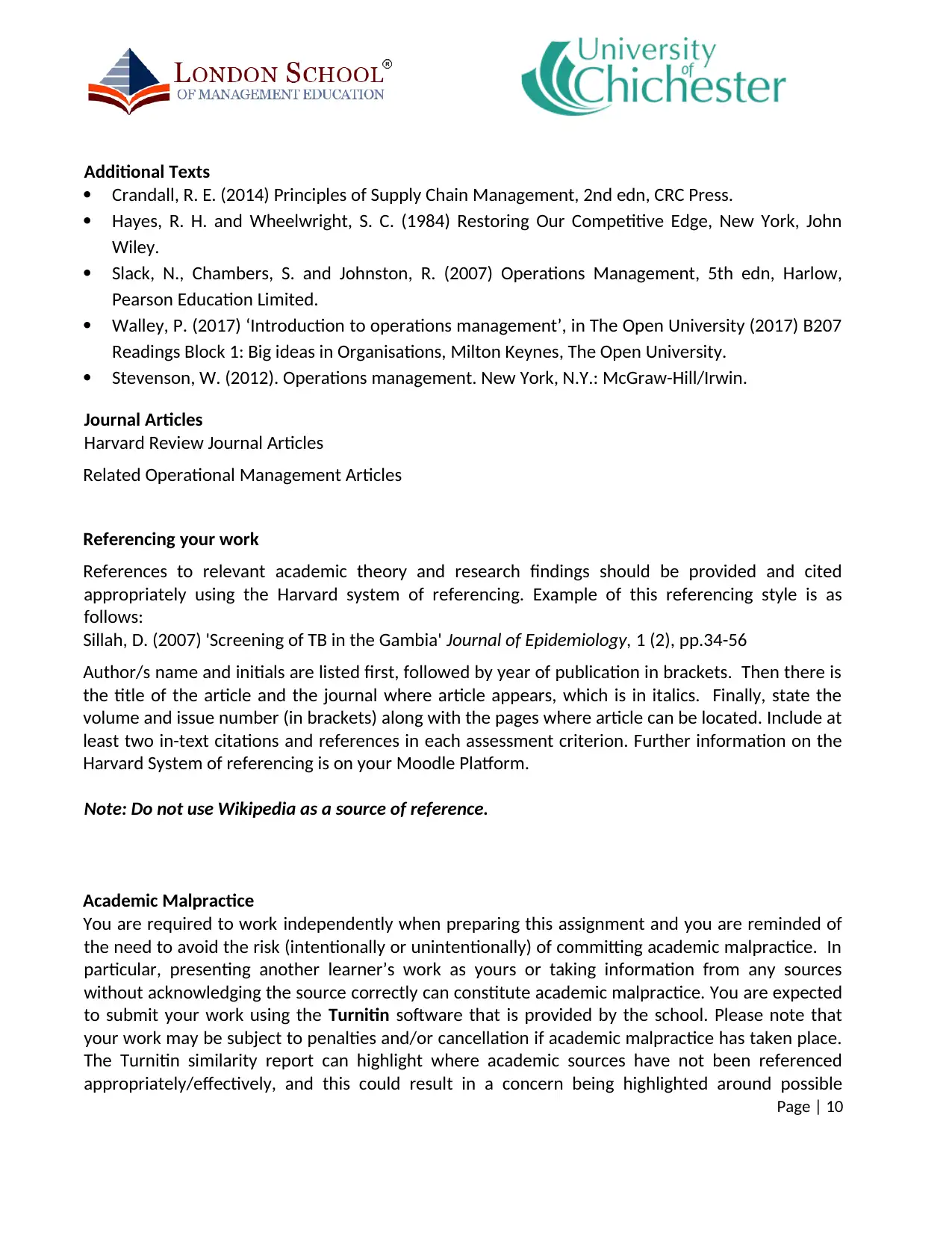
Additional Texts
Crandall, R. E. (2014) Principles of Supply Chain Management, 2nd edn, CRC Press.
Hayes, R. H. and Wheelwright, S. C. (1984) Restoring Our Competitive Edge, New York, John
Wiley.
Slack, N., Chambers, S. and Johnston, R. (2007) Operations Management, 5th edn, Harlow,
Pearson Education Limited.
Walley, P. (2017) ‘Introduction to operations management’, in The Open University (2017) B207
Readings Block 1: Big ideas in Organisations, Milton Keynes, The Open University.
Stevenson, W. (2012). Operations management. New York, N.Y.: McGraw-Hill/Irwin.
Journal Articles
Harvard Review Journal Articles
Related Operational Management Articles
Referencing your work
References to relevant academic theory and research findings should be provided and cited
appropriately using the Harvard system of referencing. Example of this referencing style is as
follows:
Sillah, D. (2007) 'Screening of TB in the Gambia' Journal of Epidemiology, 1 (2), pp.34-56
Author/s name and initials are listed first, followed by year of publication in brackets. Then there is
the title of the article and the journal where article appears, which is in italics. Finally, state the
volume and issue number (in brackets) along with the pages where article can be located. Include at
least two in-text citations and references in each assessment criterion. Further information on the
Harvard System of referencing is on your Moodle Platform.
Note: Do not use Wikipedia as a source of reference.
Academic Malpractice
You are required to work independently when preparing this assignment and you are reminded of
the need to avoid the risk (intentionally or unintentionally) of committing academic malpractice. In
particular, presenting another learner’s work as yours or taking information from any sources
without acknowledging the source correctly can constitute academic malpractice. You are expected
to submit your work using the Turnitin software that is provided by the school. Please note that
your work may be subject to penalties and/or cancellation if academic malpractice has taken place.
The Turnitin similarity report can highlight where academic sources have not been referenced
appropriately/effectively, and this could result in a concern being highlighted around possible
Page | 10
Crandall, R. E. (2014) Principles of Supply Chain Management, 2nd edn, CRC Press.
Hayes, R. H. and Wheelwright, S. C. (1984) Restoring Our Competitive Edge, New York, John
Wiley.
Slack, N., Chambers, S. and Johnston, R. (2007) Operations Management, 5th edn, Harlow,
Pearson Education Limited.
Walley, P. (2017) ‘Introduction to operations management’, in The Open University (2017) B207
Readings Block 1: Big ideas in Organisations, Milton Keynes, The Open University.
Stevenson, W. (2012). Operations management. New York, N.Y.: McGraw-Hill/Irwin.
Journal Articles
Harvard Review Journal Articles
Related Operational Management Articles
Referencing your work
References to relevant academic theory and research findings should be provided and cited
appropriately using the Harvard system of referencing. Example of this referencing style is as
follows:
Sillah, D. (2007) 'Screening of TB in the Gambia' Journal of Epidemiology, 1 (2), pp.34-56
Author/s name and initials are listed first, followed by year of publication in brackets. Then there is
the title of the article and the journal where article appears, which is in italics. Finally, state the
volume and issue number (in brackets) along with the pages where article can be located. Include at
least two in-text citations and references in each assessment criterion. Further information on the
Harvard System of referencing is on your Moodle Platform.
Note: Do not use Wikipedia as a source of reference.
Academic Malpractice
You are required to work independently when preparing this assignment and you are reminded of
the need to avoid the risk (intentionally or unintentionally) of committing academic malpractice. In
particular, presenting another learner’s work as yours or taking information from any sources
without acknowledging the source correctly can constitute academic malpractice. You are expected
to submit your work using the Turnitin software that is provided by the school. Please note that
your work may be subject to penalties and/or cancellation if academic malpractice has taken place.
The Turnitin similarity report can highlight where academic sources have not been referenced
appropriately/effectively, and this could result in a concern being highlighted around possible
Page | 10
Paraphrase This Document
Need a fresh take? Get an instant paraphrase of this document with our AI Paraphraser
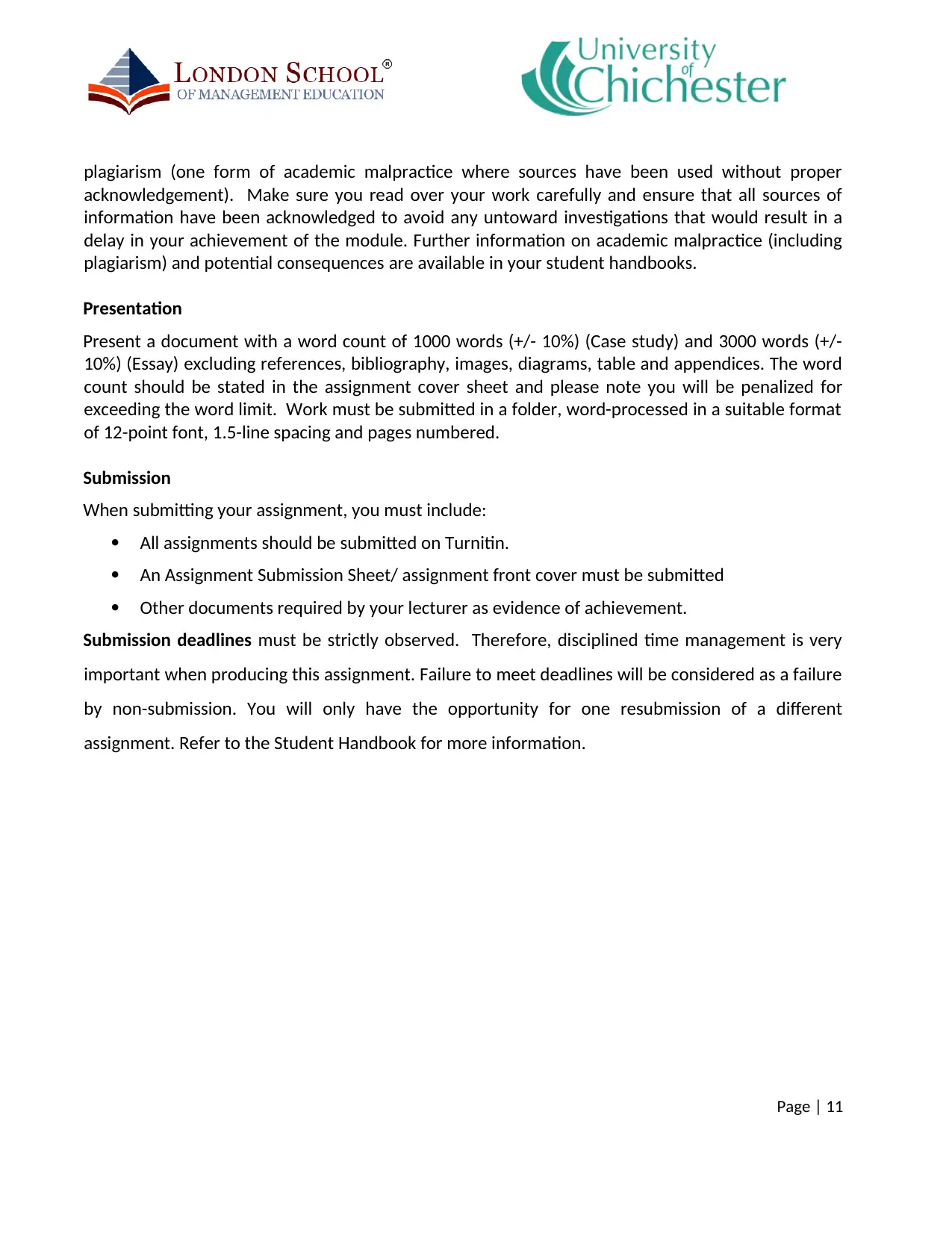
plagiarism (one form of academic malpractice where sources have been used without proper
acknowledgement). Make sure you read over your work carefully and ensure that all sources of
information have been acknowledged to avoid any untoward investigations that would result in a
delay in your achievement of the module. Further information on academic malpractice (including
plagiarism) and potential consequences are available in your student handbooks.
Presentation
Present a document with a word count of 1000 words (+/- 10%) (Case study) and 3000 words (+/-
10%) (Essay) excluding references, bibliography, images, diagrams, table and appendices. The word
count should be stated in the assignment cover sheet and please note you will be penalized for
exceeding the word limit. Work must be submitted in a folder, word-processed in a suitable format
of 12-point font, 1.5-line spacing and pages numbered.
Submission
When submitting your assignment, you must include:
All assignments should be submitted on Turnitin.
An Assignment Submission Sheet/ assignment front cover must be submitted
Other documents required by your lecturer as evidence of achievement.
Submission deadlines must be strictly observed. Therefore, disciplined time management is very
important when producing this assignment. Failure to meet deadlines will be considered as a failure
by non-submission. You will only have the opportunity for one resubmission of a different
assignment. Refer to the Student Handbook for more information.
Page | 11
acknowledgement). Make sure you read over your work carefully and ensure that all sources of
information have been acknowledged to avoid any untoward investigations that would result in a
delay in your achievement of the module. Further information on academic malpractice (including
plagiarism) and potential consequences are available in your student handbooks.
Presentation
Present a document with a word count of 1000 words (+/- 10%) (Case study) and 3000 words (+/-
10%) (Essay) excluding references, bibliography, images, diagrams, table and appendices. The word
count should be stated in the assignment cover sheet and please note you will be penalized for
exceeding the word limit. Work must be submitted in a folder, word-processed in a suitable format
of 12-point font, 1.5-line spacing and pages numbered.
Submission
When submitting your assignment, you must include:
All assignments should be submitted on Turnitin.
An Assignment Submission Sheet/ assignment front cover must be submitted
Other documents required by your lecturer as evidence of achievement.
Submission deadlines must be strictly observed. Therefore, disciplined time management is very
important when producing this assignment. Failure to meet deadlines will be considered as a failure
by non-submission. You will only have the opportunity for one resubmission of a different
assignment. Refer to the Student Handbook for more information.
Page | 11
1 out of 11
Related Documents
Your All-in-One AI-Powered Toolkit for Academic Success.
+13062052269
info@desklib.com
Available 24*7 on WhatsApp / Email
![[object Object]](/_next/static/media/star-bottom.7253800d.svg)
Unlock your academic potential
Copyright © 2020–2025 A2Z Services. All Rights Reserved. Developed and managed by ZUCOL.





